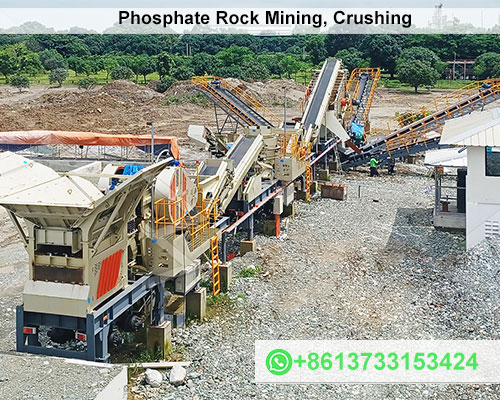Phosphate Rock Mining, Crushing, and Processing
Phosphate rock is a sedimentary rock that contains high concentrations of phosphate minerals, primarily apatite. It is an essential raw material for the production of phosphorus, which is a critical nutrient for plant growth. Phosphate rock is mined from various locations around the world, and the mining process can vary depending on the deposit’s characteristics. Once mined, the phosphate rock must be crushed and processed to extract the valuable phosphate minerals.

Mining
Phosphate rock can be mined using surface or underground methods. Surface mining is the most common method, as it is more cost-effective for shallow deposits. In surface mining, overburden (the material that covers the phosphate rock) is removed using shovels or excavators, and the phosphate rock is then extracted. Underground mining is used for deeper deposits, and involves drilling shafts and tunnels to access the phosphate rock.
Crushing
Once mined, the phosphate rock is transported to a processing plant where it is crushed into smaller pieces. This is done using a variety of crushing equipment, such as jaw crusher, gyratory crusher, and cone crusher. The size of the crushed phosphate rock depends on the downstream processing method.
Grinding
After crushing, the phosphate rock is then ground into a fine powder. This is typically done using ball mills or rod mills. The grinding process further liberates the phosphate minerals from the gangue minerals (impurities).
Beneficiation
The ground phosphate rock is then subjected to a beneficiation process to separate the phosphate minerals from the gangue minerals. This is typically done using flotation, a process that utilizes the different surface properties of the minerals to separate them in a water-based slurry.
Drying and Shipping
The beneficiated phosphate rock is then dewatered and dried. The dried phosphate rock is the final product and is shipped to fertilizer plants where it is converted into phosphoric acid, a key ingredient in fertilizers.
Environmental Considerations
Phosphate rock mining and processing can have significant environmental impacts. These impacts include:
- Habitat destruction: Mining and processing operations can destroy natural habitats, including forests and wetlands.
- Water pollution: The release of wastewater from processing plants can pollute water sources.
- Air pollution: Dust emissions from mining and processing operations can contribute to air pollution.
- Land degradation: Improper waste disposal can lead to land degradation.
Mining companies are required to take measures to mitigate these environmental impacts. These measures may include:
- Reclamation of mined land: Mined land can be reclaimed by restoring the original contours and vegetation.
- Treatment of wastewater: Wastewater can be treated to remove pollutants before it is discharged into the environment.
- Dust suppression: Dust suppression techniques can be used to reduce dust emissions.
- Proper waste disposal: Waste materials can be disposed of in a safe and environmentally sound manner.
Phosphate rock is an essential resource for the production of fertilizers, which are critical for global food security. However, phosphate rock mining and processing can have significant environmental impacts. Mining companies must take measures to mitigate these impacts and ensure that their operations are conducted in a sustainable manner.









